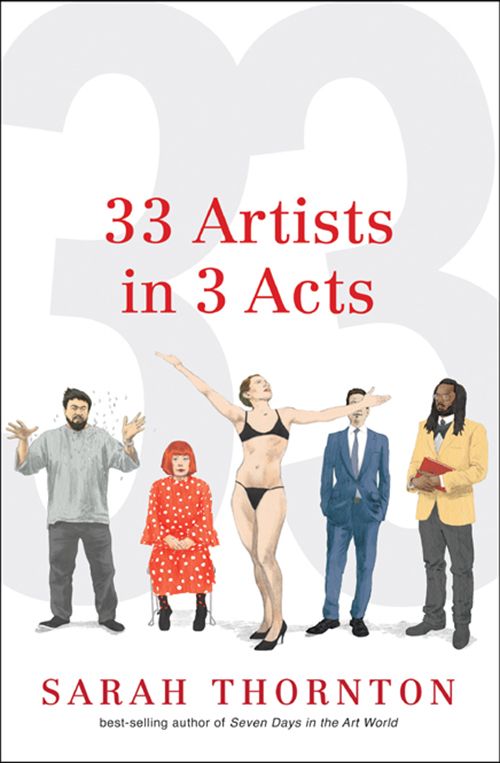
33 Artists in 3 Acts
کتاب های مرتبط
- اطلاعات
- نقد و بررسی
- دیدگاه کاربران
نقد و بررسی

Starred review from August 4, 2014
Thornton (Seven Days in the Art World) paints a masterful picture of 33 artists, keenly bringing details of their lives to the surface with a skilled hand and without overwhelming the reader. The product of four years of work, the book is divided into its eponymous three acts; each chapter, or “scene,” focuses on one artist, with artists sometimes appearing in multiple “scenes.” The activist Chinese artist, Ai Weiwei, receives much favorable attention; one notable chapter takes place in the wake of his arrest at the hands of Chinese government authorities. Married American artists Caroll Dunham and Laurie Simmons are surveyed together, then separately, in multiple chapters, with Thornton exploring their artistic relationships and the gender dynamics therein. Thornton builds on such analyses to offer astute, accessible commentary on the gendered dimensions of modern art. With effortless sophistication, Thornton takes readers on a journey across the globe and into the homes and minds of contemporary artists. In the process, she banishes cynicism about modern art, revealing it to be a volatile, healthy enterprise still deeply engaged with the world. 44 illus. Agent: Sarah Chalfant, the Wylie Agency.

Starred review from November 1, 2014
The intrepid and inquisitive Thornton once again guides readers on a journey through the often confounding upper echelons of twenty-first-century art. In her best-selling Seven Days in the Art World (2008), this art historian, sociologist, and chief art writer for The Economist ushered us into art's spheres of commerce. In her new, even more revealing and resonant book, artists take center stage. Thornton is curious about how artists address concerns personal, societal, and professional. In the post-Duchampian world of anything-is-art-if-the-artist-says-it-is, many artists find that they cannot concentrate solely on making art because they need to establish a public persona to represent and promote their work. Therefore, Thornton perceives, artists' studios have become private stages for the daily rehearsal of self-belief. The 3 acts of the title refer to how this effort plays out in three realms politics, kinship, and craft. Between 2009 and 2013, Thornton traveled to 14 countries on four continents and visited 130 artists. The 33 who made the cut are all well-established as well as, in most cases, open, articulate, and honest. Curiously, Thornton discovered that the most problematic question she posed was, What is an artist? That's because, in part, the romantic view of the artist as a struggling loner has been eclipsed. Successful artists are now entrepreneurs and ideas people liberated from manual labor as they oversee sizable administrative and production staffs working in state-of-the-art facilitiesdigital versions, Thornton observes, of the bustling ateliers of top Renaissance painters. With her acutely perceptive reportorial eye and keen ear, Thornton not only discerningly profiles each artist; she also contrasts and compares them. In the book's most provocative pairing, Thornton considers the slick, calculating, megarich American Jeff Koons versus the courageous, forthright, besieged Chinese artist and human rights activist Ai Weiwei, famous for such installations as Sunflower Seeds (2010), in which 100 million handmade, painted porcelain sunflower seeds covered the floor of a vast hall in London's Tate Modern. Thornton meets with cheery Koons in his fancy, high-tech command center and tries to steer him away from his well-rehearsed patter, while she is deeply moved by Ai's candor, determination, and ethical valor when she visits him in his raided and decimated studio after his arrest and grueling detention. Thornton runs into Koons at art events all around the world, while Ai, his passport confiscated, remains under house arrest, unable to attend the installation of his own exhibits in the U.S. and elsewhere. Thornton spends time with Koons' British counterpart, headline-grabbing, big-money Damien Hirst, who is trying to return to painting after years of putting sharks in tanks and covering skulls with jewels. She also illuminates the lives and work of such thoughtful, risk-taking, socially concerned, poetic, and ironic artists as, in Mexico, Gabriel Orozco, in Chile, Eugenio Dittborn. Each encounter is a revelation. In the kinship category, Thornton considers complications and affirmations within a family of artists: plucky and unnerving photographer Laurie Simmons, who has recently created a series of portraits of an eerily realistic Japanese sex doll; painter Carroll Dunham, who creates comically, grotesquely, and earthily explicit figures; and their daughter, writer-director-actor-producer Lena Dunham of HBO's Girls. Kinship takes on a broader definition in Thornton's portrait of photographer and sculptor Rashid Johnson, who is fascinated with the problem of how to be black. Thornton reveals the artist behind the many...

























دیدگاه کاربران